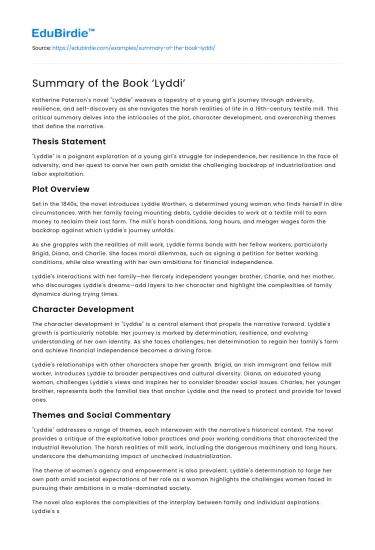Katherine Paterson's novel "Lyddie" weaves a tapestry of a young girl's journey through adversity, resilience, and self-discovery as she navigates the harsh realities of life in a 19th-century textile mill. This critical summary delves into the intricacies of the plot, character development, and overarching themes that define the narrative.
Thesis Statement
"Lyddie" is a poignant exploration of a young girl's struggle for independence, her resilience in the face of adversity, and her quest to carve her own path amidst the challenging backdrop of industrialization and labor exploitation.
Save your time!
We can take care of your essay
- Proper editing and formatting
- Free revision, title page, and bibliography
- Flexible prices and money-back guarantee
Plot Overview
Set in the 1840s, the novel introduces Lyddie Worthen, a determined young woman who finds herself in dire circumstances. With her family facing mounting debts, Lyddie decides to work at a textile mill to earn money to reclaim their lost farm. The mill's harsh conditions, long hours, and meager wages form the backdrop against which Lyddie's journey unfolds.
As she grapples with the realities of mill work, Lyddie forms bonds with her fellow workers, particularly Brigid, Diana, and Charlie. She faces moral dilemmas, such as signing a petition for better working conditions, while also wrestling with her own ambitions for financial independence.
Lyddie's interactions with her family—her fiercely independent younger brother, Charlie, and her mother, who discourages Lyddie's dreams—add layers to her character and highlight the complexities of family dynamics during trying times.
Character Development
The character development in "Lyddie" is a central element that propels the narrative forward. Lyddie's growth is particularly notable. Her journey is marked by determination, resilience, and evolving understanding of her own identity. As she faces challenges, her determination to regain her family's farm and achieve financial independence becomes a driving force.
Lyddie's relationships with other characters shape her growth. Brigid, an Irish immigrant and fellow mill worker, introduces Lyddie to broader perspectives and cultural diversity. Diana, an educated young woman, challenges Lyddie's views and inspires her to consider broader social issues. Charles, her younger brother, represents both the familial ties that anchor Lyddie and the need to protect and provide for loved ones.
Themes and Social Commentary
"Lyddie" addresses a range of themes, each interwoven with the narrative's historical context. The novel provides a critique of the exploitative labor practices and poor working conditions that characterized the Industrial Revolution. The harsh realities of mill work, including the dangerous machinery and long hours, underscore the dehumanizing impact of unchecked industrialization.
The theme of women's agency and empowerment is also prevalent. Lyddie's determination to forge her own path amid societal expectations of her role as a woman highlights the challenges women faced in pursuing their ambitions in a male-dominated society.
The novel also explores the complexities of the interplay between family and individual aspirations. Lyddie's struggles to reconcile her desire for personal success with her sense of responsibility toward her family poignantly reflect the broader societal tensions of the time.
Conclusion: A Tapestry of Resilience and Discovery
"Lyddie" weaves a rich tapestry of a young girl's resilience and discovery in the midst of economic upheaval and societal change. The critical summary showcases the depth of character development, the exploration of pressing themes, and the historical context that collectively contribute to the novel's compelling narrative.
As readers journey alongside Lyddie, they are exposed to a vivid portrayal of the challenges and triumphs that defined the lives of individuals during a transformative period in history. Katherine Paterson masterfully crafts a narrative that invites critical reflection on the intersections of personal aspirations, societal expectations, and the pursuit of a better life in the face of adversity.






 Stuck on your essay?
Stuck on your essay?

